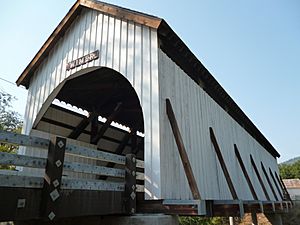Evans Creek (Rogue River tributary) facts for kids
Quick facts for kids Evans Creek |
|
|---|---|

Wimer Bridge crosses the creek in Wimer
|
|
|
Location of the mouth of Evans Creek in Oregon
|
|
| Country | United States |
| State | Oregon |
| County | Jackson |
| Physical characteristics | |
| Main source | 42°45′04″N 122°56′27″W / 42.75111°N 122.94083°W |
| River mouth | Rogue River Rogue River 991 ft (302 m) 42°25′57″N 123°10′36″W / 42.43250°N 123.17667°W |
| Length | 36 mi (58 km) |
| Basin features | |
| Basin size | 224 sq mi (580 km2) |
Evans Creek is a stream in Oregon, USA. It is about 35 miles (56 kilometers) long. This creek flows into the bigger Rogue River. It is an important home for fish like salmon and steelhead trout.
Contents
Exploring Evans Creek
Evans Creek starts high up near Richter Mountain. This mountain is part of the Cascade Range. The creek then flows generally south. It passes through a place called The Meadows. After that, it turns southwest towards Wimer. Finally, it flows south to the city of Rogue River. All of this happens within Jackson County.
Where Does Evans Creek Flow?
The creek eventually joins the Rogue River. This meeting point is about 111 miles (179 kilometers) from where the Rogue River empties into the Pacific Ocean.
Rivers and Bridges
A special bridge crosses Evans Creek at Wimer. It is called the Wimer Bridge. This bridge is a one-lane covered bridge. It looks very old and unique.
Other Streams Joining In
Many smaller streams flow into Evans Creek. These are called tributaries. Starting from where Evans Creek begins, some of these streams are:
- Railroad Gap Creek
- Wolf Creek
- Coal Creek
- Chapman Creek
- Canon Creek
- Morrison Creek
Further downstream, more streams join:
- Spignet Creek
- West Fork Evans Creek
- May Creek
- Sykes Creek
- Pleasant Creek
The last streams to join are Bear Branch and Fielder Creek.
Helping Fish Thrive
For a long time, two old dams were on Evans Creek. These dams made it hard for fish to swim upstream. This was a big problem for fish like salmon and steelhead. These fish need to swim upstream to lay their eggs.
In 2015, these two dams were taken down. They were called the Wimer Dam and the Fielder Dam. The Wimer Dam was about 9 miles (14 kilometers) from the mouth of Evans Creek. The Fielder Dam was even closer to the mouth.
Removing these dams was a huge success. It opened up about 70 miles (113 kilometers) of stream channels. Now, salmon and steelhead can swim freely again. This helps them reach their spawning grounds. It makes Evans Creek a much better home for these important fish.


